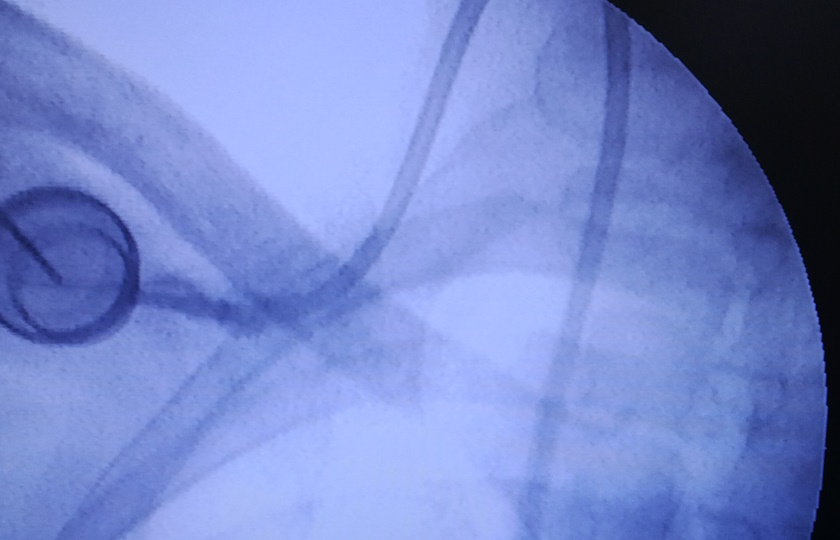
Chemoport Insertion Procedure: Everything You Should Know
What is Chemoport Insertion Procedure?
Chemoport, or simply ‘port’, is a small medical appliance that is installed beneath the skin. It allows healthcare professionals & doctors to easily access your bloodstream and is often used to administer chemotherapy drugs, draw blood, or provide other treatments. The chemoport insertion procedure is typically performed by a vascular surgeon and is often a short, outpatient procedure.
Chemoport Insertion Surgery: Indications and Candidate Suitability
When is Chemoport Insertion Recommended?
Chemoport insertion is recommended for patients who require frequent and long-term access to their bloodstream for the administration of treatments. This is particularly common in the following cases:
Chemotherapy: Patients undergoing chemotherapy often need multiple sessions over weeks or months. Chemoports facilitate the safe and effective delivery of chemotherapeutic drugs without damaging peripheral veins.
Long-term Intravenous Antibiotics: Individuals requiring prolonged antibiotic treatment benefit from chemoports to avoid repeated needle sticks and reduce the risk of venous irritation or damage.
Nutritional Support: For patients who require long-term total parenteral nutrition (TPN), chemoports provide a reliable means of delivering essential nutrients directly into the bloodstream.
Blood Draws: Patients who need frequent blood tests due to their medical conditions find chemoports beneficial as they reduce discomfort and the need for multiple venipunctures.
Who are Suitable Candidates for Chemoport Insertion?
Chemoport insertion is suitable for patients who:
- Have poor peripheral venous access, making traditional IV access difficult or painful.
- Need medications that can cause irritation or damage to smaller veins, necessitating access to larger central veins.
- Require a reliable and long-term method for medication delivery, particularly when oral administration is not an option.
- Show a preference for a more convenient and less painful method to manage frequent treatments.
Safety and Considerations.
The procedure to insert a chemoport is generally safe, carried out under local anesthesia, and often completed within an hour. While complications are rare, potential risks include infection, bleeding, and, in very rare cases, pneumothorax (air in the chest cavity). Dr. Sumit Kapadia ensures that all patients are thoroughly evaluated to determine their suitability for the procedure and are fully informed of the benefits and risks involved.
This revised section should offer readers a clearer understanding of when a chemoport is required, who benefits most from its insertion, and what to expect in terms of safety and procedural considerations. This helps in aligning the content more closely with user needs and search engine optimization criteria, making it more relevant and useful.
Understanding Chemoport Components and Their Functions
Chemoport Components Explained:
A chemoport is a crucial device used in the administration of long-term intravenous treatments, such as chemotherapy. It consists of three primary components, each playing a vital role in the functionality and effectiveness of the port:
Portal: This is the reservoir that sits beneath the skin. It’s usually made of durable materials like plastic or metal to withstand the repeated access required during treatment.
Septum: Positioned on the top of the portal, the septum is crafted from a self-sealing rubber. This design allows needles to be inserted through it numerous times for drug administration or blood withdrawal without compromising the port’s integrity.
Catheter: A thin, flexible tube that extends from the portal to a large central vein near the heart. This arrangement allows for efficient and direct delivery of treatment agents into the bloodstream.
These components work together to provide a safe, effective, and less painful method of receiving intravenous therapies, particularly for patients undergoing frequent or long-term treatment.
Chemoport Insertion Cost in India
The cost of chemoport insertion varies widely in India, depending on the hospital, the expertise of the vascular surgeon, and the specific circumstances of the patient. On average, the procedure can cost anywhere from INR 50,000 to INR 1,00,000. While this may seem like a significant investment, it’s important to consider the comfort, convenience, and safety benefits that a chemoport can provide.
The cost of chemoport insertion can vary widely depending on multiple factors including the doctor, location, and specific patient requirements. As a highly experienced and reputed vascular surgeon, Dr. Sumit Kapadia, is well-versed in providing high-quality care tailored to the patient’s specific needs and budget. He ensures that his patients are well-informed about the procedure costs upfront, allowing them to make informed decisions about their treatment plan. It’s advisable to discuss the cost with your doctor & insurance company to understand the extent of coverage for the chemoport insertion procedure.
Also read: The Role of Vascular Surgeons in Dialysis Patients
Understanding Chemoport Components and Their Functions
A chemoport is comprised of three main components: the portal, the septum, and the catheter. The portal is a reservoir, often made of plastic or metal, implanted under the skin. The septum, a part of the portal, is made from self-sealing rubber material, allowing needles to pass through it numerous times without causing damage. The catheter is a thin, flexible tube that connects the port to a large central vein that leads to your heart.
As for safety, a question that patients often ask Dr. Sumit Kapadia is: “Is a chemo port safe?” The answer, in most cases, is a resounding yes. The chemoport insertion procedure is considered a safe and routinely performed procedure with minimal serious complications. However, as with any surgical procedure, some risk exists, and this will be thoroughly discussed prior to the procedure.
How to Prepare for Chemoport Insertion Surgery?
Dr. Sumit Kapadia provides comprehensive guidelines to his patients on how to prepare for a chemoport insertion procedure. This often involves fasting (avoiding food and drink) for a few hours prior to the surgery. Some medications might need to be temporarily stopped or adjusted, so it is important to provide the doctor / vascular surgeon with a complete list of all the medications you are taking. This includes prescription medications, over-the-counter drugs, and even dietary supplements.
Pre-procedure discussions and evaluations with Dr. Sumit Kapadia will include an assessment of your overall health, explanation of the procedure, and its benefits and risks. Often a neck doppler or ultrasound is required to assess the size of the neck veins to be utilised for chemoport. This is an ideal time to clarify any doubts or concerns about the chemoport insertion procedure.
How is chemoport placed?
Usually, the procedure is performed under local anesthesia or mild sedation, in a dedicated sterile Operation theatre.
The neck vein is punctured under doppler guidance and a guide wire is passed till the heart. The catheter is passed over the wire and the position of the tip is checked under an X-ray or C-Arm. The other end of the catheter tunnelled beneath the collar bone and is connected to the portal, which is then implanted beneath the skin through a small incision.
Care of the Chemoport
After the chemoport insertion procedure, Dr. Sumit Kapadia and his vascular doctors team will provide detailed instructions on how to care for the chemoport and the skin around it. It is of utmost importance to keep this area clean and dry to prevent any potential infections.
Additionally, you should avoid heavy lifting or strenuous activities for a period of time as directed by Dr. Sumit. This helps ensure the chemoport remains in place and reduces the risk of any post-surgical complications.
Remember, regular follow-up appointments with Dr. Sumit Kapadia or your treating doctor will be scheduled to monitor your chemoport and ensure it is functioning correctly and there are no associated complications
Conclusion:
Chemoport insertion can play a crucial role in easing the process of chemotherapy for patients, enhancing their comfort, and ensuring efficient and safe delivery of medications. Dr. Sumit Kapadia, with his vast expertise in vascular surgery, is committed to offering the highest standard of care to his patients. He guides his patients through every step of the process, ensuring they are well-prepared for the procedure, fully informed about the care and maintenance of the chemoport, and aware of the costs involved.
In conclusion, while chemoport insertion is a commonly performed and safe procedure, patients should have a clear understanding of the process, benefits, potential complications, and the costs involved. Always remember that open communication with your doctor in this case, Dr. Sumit Kapadia, is key to ensuring optimal outcomes.
Frequently Asked Questions about Chemoport Insertion
The chemoport insertion procedure generally involves the following steps:
Preparation: The patient undergoes an evaluation, including imaging studies to identify suitable veins. The area of insertion is cleaned and prepared.
Anesthesia: Local anesthesia is administered to numb the insertion site.
Venous Access: Using ultrasound guidance, a vein (typically in the neck or upper chest) is accessed with a needle.
Guide Wire Insertion: A guide wire is inserted through the needle into the vein.
Making the Pocket: A small incision is made to create a pocket under the skin where the port will sit.
Catheter Placement: The catheter, connected to the port, is threaded over the guide wire into the vein toward the heart.
Securing and Testing: The port is placed into the pocket and secured. The catheter’s position is checked via X-ray, and the port is tested for proper flow.
Closure: The incision is closed with sutures, and a dressing is applied.
The most commonly used veins for chemoport insertion are the internal jugular vein in the neck and the subclavian vein in the chest. These veins offer direct access to the superior vena cava, which leads to the heart.
A chemoport is inserted under sterile conditions in an operating room or interventional radiology suite. After administering local anesthesia, a vascular surgeon makes a small incision near the target vein and another incision where the port will be seated. The catheter is inserted into the vein and guided towards the heart, and the port is secured under the skin.
The procedure typically takes about 30 to 60 minutes to complete, depending on the patient’s specific conditions and the complexity of the insertion.
Insertion of a needle into a chemoport involves using a non-coring needle, also known as a Huber needle. The skin over the port is cleaned, and the needle is inserted at a 90-degree angle to the skin directly over the septum of the port to access the reservoir for medication delivery or blood drawing.
While generally safe, chemoport complications can include infection, thrombosis (blood clots), pneumothorax (collapsed lung), hematoma (bruising), and catheter migration or fracture. Proper care and monitoring reduce the risk of these complications.
The risks associated with using a chemoport include infection at the insertion site, clotting around the catheter, and, rarely, more serious complications such as air embolism or catheter malposition. These risks are minimized with proper technique and post-operative care.
The best side for chemoport placement is usually determined by patient comfort, the presence of any prior surgeries, radiation treatments, or the specific anatomy of the patient. Typically, the non-dominant side is preferred to minimize discomfort during routine activities.
Follow us on YouTube

MBBS, MS, MRCS, DNB-Fellow
Dr. Sumit Kapadia
Dr. Sumit Kapadia / MR KAPADIA SUMIT a gold-medalist from Baroda Medical College, obtained his general surgical training and senior residency from SSG Hospital, Vadodara.

MBBS, MS, MRCS, DNB-Fellow
Dr. Sumit Kapadia
Dr. Sumit Kapadia / MR KAPADIA SUMIT a gold-medalist from Baroda Medical College, obtained his general surgical training and senior residency from SSG Hospital, Vadodara.




